Abstract
The effect of organic amendment on the resistance and resilience of the organic matter decomposing activity was compared between soils amended with compost and with chemical fertilizers. The impact of metam sodium disinfection on cellulose-decomposing activity and on the number of nematodes in three types of soils was periodically measured. In an andosol, cellulose-decomposing activity was significantly suppressed by soil disinfection only in the chemically fertilized soil (CF-soil) and not in the soils to which cow manure compost and okara (the residue in tofu production)/coffee compost was added. In a brown lowland soil, cellulose-decomposing activity was significantly suppressed by soil disinfection in the CF-soil, but not in the soils to which higher amounts of cow manure compost and pig manure compost had been added. In a red-yellow soil, cellulose-decomposing activity was significantly suppressed by soil disinfection in all soils, but its resilience was higher in the soils to which cow manure compost or coffee compost was added compared with the CF-soil. Total numbers of nematodes were markedly decreased by soil disinfection in all soils. These results may suggest that the resistance and resilience of cellulose-decomposing activity against soil disinfection were enhanced by organic amendments, while disinfection had fatal effects on soil nematodes. In most of the organically amended soils, the mean weight diameters of aggregates were larger compared with the CF-soils, suggesting that highly structured soil pore networks may provide shelters for the soil microbes responsible for cellulose decomposition against disinfection. This hypothesis was supported by the result that the resistance of cellulose-decomposing activity against soil disinfection decreased when the soil structure was destroyed by grinding in a mortal and pestle.
INTRODUCTION
Sustainable soil management is required for sustainable crop production. Soil systems are exposed to a variety of environmental stresses of natural and anthropogenic origin that can potentially affect soil functioning. The degree to which such functions are impaired following a stress can be defined as the resistance of the soil system, and the rate and extent of recovery can be considered as its resilience. CitationPimm (1984) describes resistance and resilience as the components of functional stability. CitationSeybold et al. (1999) indicated that soil resilience is an important concept in maintaining sustainability, and it is argued that resistant and/or resilient soils are desirable in the context of sustainable soil management. However, soil resilience has received limited attention, despite a growing number of soil scientists recognizing it as a fundamental component of soil quality (CitationKay et al. 1994; CitationLal 1993; CitationSeybold et al. 1999). Most work in this area has assessed soil physical resilience (CitationGriffiths et al. 2005), such as a novel measurement of the self-mulching potential of clay soils by CitationGrant et al. (1995). Soil microorganisms play a pivotal role in soil functioning, such as organic matter decomposition and nutrient cycling. Since CitationGriffiths et al. (2000) provided the first experimental and quantitative data on soil biological resilience, insights into the nature of the biological basis of resistance and resilience of soil functions have been growing (e.g. CitationDungan et al. 2003; CitationGirvan et al. 2005; CitationGriffiths et al. 2001, Citation2005; CitationWada and Toyota 2007).
Table 1 Characteristics of the soils used
The application of organic matter is accepted as an unequivocal management in sustainable crop production because it enhances soil fertility through the modification of soil physical, chemical and biological properties (e.g. CitationRoberson et al. 1995; CitationWander et al. 1994). CitationDungan et al. (2003) reported that organic amendment is related to a reduced impact of fumigation of soil. They found that microbial activity, measured as dehydrogenase activity, was decreased by soil fumigation with propargyl bromide and 1,3-dichloropropene and was suppressed throughout 12 weeks of incubation, while such activity recovered when the soil was amended with 3% (w/w) manure. CitationGriffiths et al. (2005) found that soil resilience was enhanced in soils amended with digested and undigested sewage sludge compared with unamended soils. Our previous study also demonstrated that the repeated application of farmyard manure enhanced the resistance and resilience of soil biological functions against soil disinfection (CitationWada and Toyota 2007). These results were further supported by CitationKuan et al. (2007) who found, using 26 different kinds of Scottish soils, that there was a strong correlation between soil organic carbon content and resilience after stresses. In contrast, there is evidence that soil biodiversity also confers stability to stress and disturbance (CitationBrussaard et al. 2007). Consequently, we can conclude that functional stability to environmental stresses is related to soil organic carbon concentrations and microbial diversity. However, data showing enhanced functional stability by organic amendment are limited (CitationDungan et al. 2003; CitationWada and Toyota 2007), and the mechanisms for higher resistance and resilience in soils amended with organic matter have not been evaluated.
Soil disinfectants are extensively used to control plant-parasitic nematodes and fungi and are widely used to enable continuous intensive crop production. However, their sustainability is questionable because it is unclear to what extent the functional capacity of such soils might be retained (CitationDungan et al. 2003). The objective of this study was to further evaluate the effects of organic matter application on the resistance and resilience of selected biological functions against soil disinfection and to estimate possible mechanisms for the enhanced resistance and resilience. Cellulose-decomposition activity was selected as a model function to represent carbon transformation in soil and the total number of nematodes was evaluated as the major target of soil disinfection to judge the validity of soil disinfection. One of the major characteristics in organically managed soils is enhanced soil structure (CitationWagner et al. 2007). Therefore, soil structure was investigated in relation to mechanisms for resistance and resilience.
MATERIALS AND METHODS
Soils
Organically and chemically fertilized soils were collected from Kanagawa Agricultural Experimental Station (Hiratsuka-city, Kanagawa Prefecture), National Agricultural Research Center for Western Region (Ayabe-city, Kyoto Prefecture) and experimental fields in the Nagoya University farm (Togo-town, Aichi Prefecture). The soils listed in were collected from the plough layer (0–10 cm) of 10 randomly selected parts of the field to reflect the whole plot. Part of the soil samples was air-dried for aggregate analysis and the remaining parts were sieved through a 2-mm screen and kept in a refrigerator until use. The soil texture of each control soil (only chemically fertilized soil) was SiL (clay 4%, silt 48%, sand 49%) in Hiratsuka, L (clay 13%, silt 25%, sand 63%) in Ayabe soil and LiC (clay 30%, silt 21%, sand 50%) in Nagoya soil.
Soil disinfection
Approximately 700–800 g of each soil (fresh basis) was placed into a 1-L plastic bottle, adjusted to 40% mean water-holding capacity (MWHC) (equivalent to approximately –50 kPa), pre-incubated for 7 days at 28°C prior to use and then disinfected with sodium methyl dithiocarbamate (metam sodium; Kilper, Buckman Laboratories, K.K., Tokyo, Japan) (30% active ingredient; CH3NHCSSNa) in a closed plastic vessel at a concentration of 0.29 µL g−1 dry soil (the conventional dosage) for 7 days at 28°C. The atmosphere in the vessels was then replaced with fresh air using a water-driven vacuum pump and the soils were further incubated at 28°C for 4–8 weeks. Control soils were not disinfected, but were otherwise incubated under the same conditions. Triplicate bottles were separately disinfected for each treatment, providing experimentally independent replicates of the fumigation treatment. After disinfection, a subsample was periodically taken from one bottle (total of three subsamples per treatment) for the determinations described below.
Density of nematodes
Nematodes were extracted from 10 g soil (fresh basis) using the Baermann funnel technique (CitationIngham 1994) for 2 days in triplicate (three subsamples for each treatment) at room temperature. The number of extracted nematodes was counted under a microscope (×40).
Organic matter decomposition
Carboxymethyl-cellulose, chitin and glucose (Wako Pure Chemicals, Tokyo, Japan) were used as model substrates. Five grams of each soil was placed into a 30-mL glass vial, mixed with 0.05 g of the substrates in triplicate. Then, 0.5 mL of distilled water was added to the vial and the vial was sealed with a rubber stopper. The CO2 concentration in the headspace was measured just after sealing and after 6 h of incubation at 28°C using a gas chromatography (GC-8A; Shimadzu, Kyoto, Japan) equipped with a thermal conductivity detector (TCD-GC) and a Porapaq Q column (3 mm × 2 m, 80/100 mesh; Shimadzu Good Laboratory Component Center, Tokyo, Japan). This short-term decomposing activity test was used based on the theory of the substrate-induced respiration method (CitationAnderson and Domsh, 1973). Vials without the addition of substrate were also prepared and the amount of CO2 with substrate minus that without substrate was regarded as the decomposition activity. The treatments were applied in triplicate. Total disturbance was expressed as the sum of the differences (%) at each measurement in the cellulose-decomposing activity between the disinfected and control soils based on the following equation. Hiratsuka: sum of 0, 1, 3 and 7 weeks after disinfection; Ayabe: sum of 0, 1, 2, 4 and 8 weeks; Nagoya: sum of 0, 1, 2 and 4 weeks.
Aggregate analysis
Aggregate stability was evaluated based on the fast wetting method (CitationLeBissonnais 1996). Soil was air-dried and passed through a 5-mm screen and a 2-mm screen and aggregates with diameters of 2–5 mm were collected. Then, 5 g of the aggregates was gently immersed in a 100-mL beaker with 50 mL of distilled water for 10 min. The water was sucked off with a pipette driven by a vacuum pump. The soil material was immersed in ethanol and transferred to a 37-µm sieve. The soil material on the sieve was dried overnight at 105°C and then gently dry-sieved by hand on a column of five sieves with openings of 2000, 1000, 500, 250 and 106 µm. The mass percentage of each size fraction was then measured and the mean weight diameter (MWD) was calculated.
Effect of soil structure on the resistance of organic matter decomposing activity to soil disinfection
Sieved soils (CowM38-soil in Ayabe and CowM40-soil in Nagoya) were air-dried and a part of the soil sample was ground in a pestle and mortar. The size distribution of the Ayabe soil was 65 and 12% in the fraction > 250 µm, 30 and 30% in the fraction 250–100 µm and 5 and 58% in the fraction < 100 µm, without and with grinding, respectively. The Nagoya soil was 98 and 17% in the fraction > 250 µm, 2 and 36% in the fraction 250–100 µm and 0 and 47% in the fraction < 100 µm, without and with grinding, respectively. The ground and non-ground control soils were disinfected and the organic matter decomposing activity was measured as described above.
Statistics
Significant differences among mean values were analyzed by anova protected by Fisher's range test (P < 0.05) using Excel statistics 2002 software (Social Survey Research Information, Tokyo, Japan).
RESULTS
Effect of soil disinfection on cellulose-decomposing activity
In Hiratsuka soil, cellulose-decomposing activity in the CF-soil was significantly (75%) suppressed by soil disinfection, but was not suppressed in the soils to which 3 t ha−1 year−1 of cow manure compost (CowM3-soil) and okara/coffee compost (O/C3-soil) had been added ().
Cellulose-decomposing activity in the disinfected soils was not significantly different from that in the non-disinfected soils in the CF-soil, CowM3-soil and O/C3-soil 1 week after disinfection.
In Ayabe soil, cellulose-decomposing activity was significantly suppressed by soil disinfection in the CF-soil and in the soils to which 19 and 38 t ha−1 year−1 of cow manure compost (CowM19-soil and CowM38-soil, respectively) and to which 19 t ha−1 year−1 of pig manure (PigM19-soil) had been added, but not in the soils to which 113 t ha−1 year−1 of cow manure compost (CowM113-soil) and to which 57 t ha−1 year−1 pig manure compost (PigM57-soil) been added (). In the CF-soil, CowM19-soil, CowM38-soil and PigM19-soil, cellulose-decomposing activity recovered to levels similar to the corresponding non-disinfected soils 8 weeks after disinfection. When total disturbance was calculated based on the sum of differences (%) at each measurement in the cellulose-decomposing activity between disinfected and control soils, it was highest in the CF-soil, followed by the CowM19-soil, CowM38-soil and PigM19-soil, and lowest in the CowM113-soil and PigM57-soil ().
In Nagoya soil, cellulose-decomposing activity was significantly suppressed by soil disinfection in all soils, but its resilience was different among the soils (). In soils to which 400 t (CowM400-soil) and 40 t (CowM40-soil) ha−1 year−1 of cow manure compost had been added, the cellulose-decomposing activity recovered to the level in the non-disinfected soil 2 weeks after disinfection. It took 4 weeks in soil to which 40 t ha−1 year−1 of coffee compost (Coffee40-soil) had been added until the recovery of the cellulose-decomposing activity from disinfection and the cellulose-decomposing activity did not recover in the CF-soil during the 4 weeks of incubation.
Effect of soil disinfection on nematodes
In Hiratsuka soils, Ayabe soils and Nagoya soils, the total numbers of nematodes were markedly decreased by soil disinfection in all the soils (), and differences in the numbers of nematodes between the control and disinfected soils were significant (P < 0.05), except for the CF-soil in Hiratsuka (P = 0.158) in which 80% of the total number of nematodes decreased by disinfection.
Aggregate analysis
The aggregate analysis showed that the amounts of water-stable aggregates increased with the application of organic matter in the Ayabe soil, resulting in significantly (P < 0.05) larger MWD (). A similar tendency was observed in the Nagoya soil, in which MWD increased significantly (P < 0.05) after the application of organic matter. In contrast, there were no significant differences in MWD and aggregate size distribution patterns between the CF-soil and the CowM3-soil or O/C3-soil using the Hiratsuka soil. In the Hiratsuka soil the MWD in the CF-soil was much greater than that recorded in the CF-soils of Ayabe and Nagoya (P < 0.05).
Effect of soil structure on the resistance of organic matter decomposing activity to soil disinfection
When the structure of the Ayabe soil and the Nagoya soil was destroyed by grinding and then the soils were disinfected, the decomposing abilities of cellulose in the Ayabe soil and chitin and glucose in the Nagoya soil were significantly reduced, although these abilities were not affected in the soils without grinding (). The cellulose-decomposing activity of the Nagoya soil was suppressed by soil disinfection even in soils that were not ground (53% decrease), but it was further suppressed in soils that underwent grinding (82% decrease) (). The cellulose-decomposing activity of the Ayabe soil remained low in the soil that was ground 1 week after disinfection ().
Figure 1 Effect of soil disinfection on the cellulose-decomposing ability of Hiratsuka soils to which two types of compost had been added. Error bars indicate standard deviation. **P < 0.01 (significantly different from the control). CF-soil, chemical fertilizers only; O/C3-soil, 3 t year−1 of okara/coffee extraction reside; CowM3-soil, 3 t year−1 of cow manure.
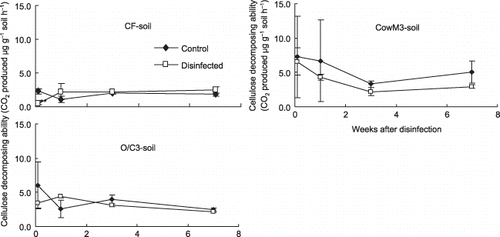
Figure 2 Effect of soil disinfection on the cellulose-decomposing ability of Ayabe soils to which two types of compost had been added. Error bars indicate standard deviation. *P < 0.05 and **P < 0.01 (significantly different from the control). CF, chemical fertilizers only; CowM19, 19 t year−1 of cow manure; CowM38, 38 t year−1 of cow manure; CowM113, 113 t year−1 of cow manure; PigM19, 19 t year−1 of pig slurry; PigM57, 57 t year−1 of pig slurry.
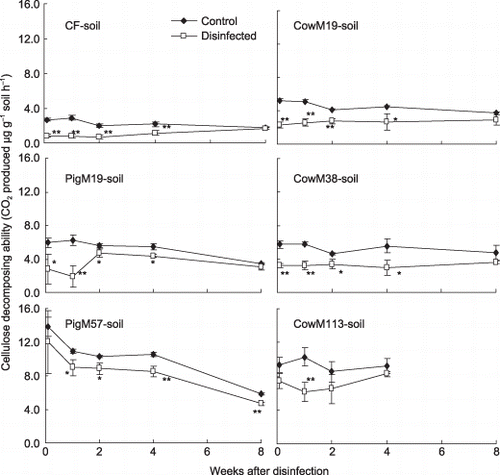
DISCUSSION
No or very few nematodes were counted in any of the metam sodium disinfected soils tested in this study (). A similar result has been reported in a previous paper in which no nematodes were extracted after soil disinfection in CF-soil and CowM40-soil in Nagoya (CitationWada and Toyota 2007). Thus, it was confirmed that the soil disinfection used in this study was conducted effectively in all soils, irrespective of organic amendment, because nematodes, the major target of soil disinfection, were generally eradicated. In addition, it has been reported that the number of ammonium oxidizers is also greatly decreased by soil disinfection using metam sodium in CF-soil and CowM40-soil in Nagoya (CitationToyota et al. 1999). In contrast, the effects of soil disinfection on cellulose-decomposing activity were different with or without organic amendment. In Hiratsuka soils, cellulose-decomposing activity was significantly suppressed by soil disinfection only in the CF-soil, but not in the CowM3-soil or the O/C3-soil (). In Ayabe soils, cellulose-decomposing activity was not significantly suppressed in PigM57-soil or CowM113-soil to which large amounts of compost had been applied, although it was suppressed in the CF-soil and in the soils with smaller amounts of compost (). These results suggested that resistance of cellulose-decomposing activity to soil disinfection may be enhanced in organically amended soils, that is, those soils to which 57 t of pig manure compost or 113 t of cow manure compost per hectare per year had been applied. In addition, it was suggested that organic amendment may enhance the soil resilience of cellulose-decomposing activity against soil disinfection because total disturbance, calculated based on the sum of differences in the cellulose-decomposing activity between disinfected and control soils, was significantly lower in all the organically amended Ayabe soils than in the CF-soil (). This result indicated that amendment with cow manure compost, even at a rate of 19 t ha−1 year−1, enhanced soil resilience.
Figure 3 Total disturbance of cellulose-decomposing activity in the different soils. Error bars indicate standard deviation and values with different letters are significantly different (P < 0.05). Total disturbance was calculated as a sum of the difference (%) in cellulose-decomposing activity between the control and the disinfected soils based on the following equation. (a) Hiratsuka: sum of 0, 1, 3 and 7 weeks after disinfection. (b) Ayabe: sum of 0, 1, 2, 4 and 8 weeks after disinfection. (c) Nagoya: sum of 0, 1, 2 and 4 weeks after disinfection. CF-soil, chemical fertilizers only; O/C3-soil, 3 t year−1 of okara/coffee extraction reside; CowM3-soil, 3 t year−1 of cow manure; CowM19, 19 t year−1 of cow manure; CowM38, 38 t year−1 of cow manure; CowM113, 113 t year−1 of cow manure; PigM19, 19 t year−1 of pig slurry; PigM57, 57 t year−1 of pig slurry; CowM40-soil, CF + 40 t year−1 of cow manure; Coffee40-soil, CF + 40 t year−1 of coffee extraction residue; CowM400-soil, 400 t year−1 of cow manure.
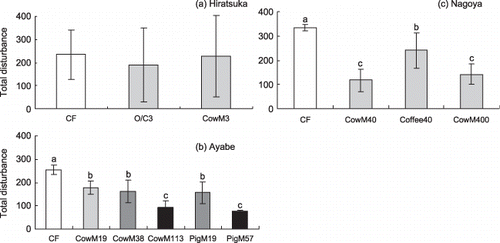
Figure 4 Effect of soil disinfection on the cellulose-decomposing ability of Nagoya soils to which two types of compost had been added. Error bars indicate standard deviation. *P < 0.05 and **P < 0.01 (significantly different from the control). CF-soil, chemical fertilizers only; CowM40-soil, CF + 40 t year−1 of cow manure; Coffee40-soil, CF + 40 t year−1 of coffee extraction residue; CowM400-soil, 400 t year−1 of cow manure.
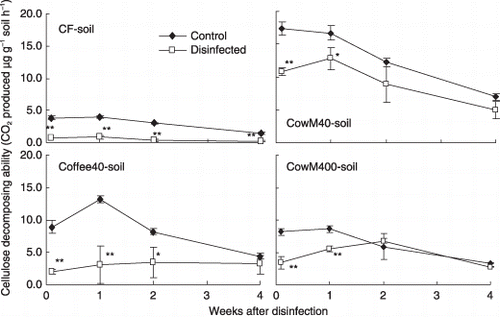
It is known that the physical structure of the soil influences the location and composition of the soil microbial community through pore size and distribution (CitationYoung and Ritz 2000) and, thus, soil structure may protect soil microorganisms from perturbation (CitationKuan et al. 2007). This may be the case because it is well known that organic amendment stimulates soil aggregation, typically expressed as higher MWD values (CitationWagner et al. 2007). In this study, Ayabe soils and Nagoya soils, in which enhancement of resilience was observed by organic amendment, showed higher MWD values in the organically managed soil than in the chemically fertilized soil, although there were no significant differences in MWD among the three Hiratuka soil plots (, , , ; ). In our previous papers, we reported that some microbial properties, such as bacterial number, community structure evaluated by the melting profile of community DNA, phospholipiol fatty acid analysis (PLFA) and Biolog were different between CF-soil and CowM40-soil in Nagoya (CitationToyota and Kuninaga 2006), and that susceptibility to Fusarium disease was also different between the CF-soil and the Coffee40-soil (CitationHamanaka et al. 2005). In addition, the present study suggested that functional stability might increase by repeated application of cow manure and coffee extraction residue composts.
Figure 5 Number of nematodes in the (a) Hiratsuka, (b) Ayabe and (c) Nagoya soils just after disinfection. Error bars indicate standard deviation. 0, no nematodes were extracted; C or Control, non-disinfected; T or Treated, disinfected. CF-soil, chemical fertilizers only; O/C3-soil, 3 t year−1 of okara/coffee extraction reside; CowM3-soil, 3 t year−1 of cow manure; CowM19, 19 t year−1 of cow manure; CowM38, 38 t year−1 of cow manure; CowM113, 113 t year−1 of cow manure; PigM19, 19 t year−1 of pig slurry; PigM57, 57 t year−1 of pig slurry; CowM40-soil, CF + 40 t year−1 of cow manure; Coffee40-soil, CF + 40 t year−1 of coffee extraction residue; CowM400-soil, 400 t year−1 of cow manure.
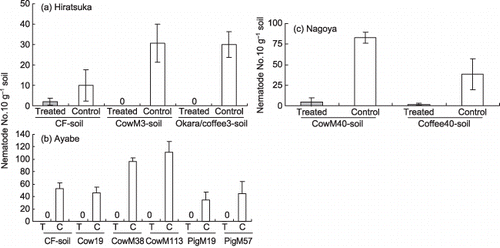
Figure 6 Organic matter decomposing ability of soils with or without grinding following soil disinfection. (a) Cellulose, (b) cellulose, (c) glucose and (d) chitin. Error bars indicate standard deviation and *P < 0.05 (significantly different from the control). (a) Ayabe CowM38-soil (38 t year−1 of cow manure). (b,c,d) Nagoya CowM40-soil (chemical fertilizer + 40 t year−1 of cow manure).
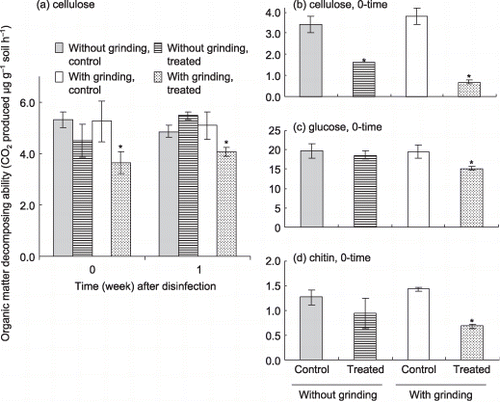
The effect of compost application on aggregate stability has already been reported by CitationUrashima et al. (1999) using the same Ayabe soils as those used in our study, in which compost application increased the ratio of macroaggregate (percentage of aggregates with > 2 mm in diameter): 113 t CowM-compost (20.4%), 39 t CowM-compost (20.3%), 19 t CowM-compost (4.9%), 57 t PigM-compost (6.3%), 19 t Pig-M-compost (22.1%) and CF-soil (0.9%), and resulted in higher MWD values in the organically amended soils. Thus, it was confirmed that even the application of cow manure compost at 19 t ha−1 year−1 markedly increased the ratio of macroaggregates. This enhanced macroaggregation may contribute to higher resistance and resilience to perturbation in soil to which compost has been applied. Indeed, when the soil structure of CowM38-soil in Ayabe and CowM40-soil in Nagoya was destroyed by grinding in a mortal and pestle, the treated soils became more susceptible to soil disinfection (), suggesting that soil physical structure may provide protective niches for soil microorganisms from perturbation, such as soil disinfection. Nematodes prefer inter-aggregate spaces rather than the insides of aggregates because of their body sizes and, thus, may be easily killed by soil disinfection. It has been shown that the bacterial wilt pathogen Ralstonia solanacearum prefers larger pore sizes which soil disinfection affects more efficiency (CitationToyota and Kimura 1996, Citation2000). Fungi, to which most soil-borne plant pathogens belong, are known to reside mainly in the outer aggregates rather than in the inner aggregates (CitationHattori 1973). In addition, fungi tend to be damaged more by soil fumigation than bacteria (CitationToyota et al. 1996). Consequently, organic amendment stimulates macroaggregation and provides a more diverse and protective physical structure to soil microorganisms, resulting in the supply of sheltered niches that are beneficial to soil microorganisms. It is possible that the major soil-borne plant pathogens, such as fungal pathogens and bacterial wilt pathogen and plant-parasitic nematodes, live in inter-aggregates that will be more affected by perturbation and are easily damaged. In contrast, microorganisms playing a key role in soil functioning, such as organic matter decomposition, presumably reside in intra-aggregates that will be less damaged by perturbation.
This study demonstrated that higher amounts of compost conferred higher stability in cellulose-decomposing activity to soil disinfection in Nagoya and Ayabe soils. In contrast, it is known that soil to which 400 t ha−1 year−1 of cow manure compost has been applied in Nagoya has a high risk of nitrate pollution to underground water (CitationKatayama et al. 2002). In Ayabe soil, it has been reported that the zinc content in the PigM57-soil exceeded its regulation (120 mg kg−1) after 10 years of repeated application and after 12 years in the PigM19-soil (CitationAsada et al. 2006; CitationHori et al. 2005). As total zinc content after 10 years of repeated application in CowM113-soil was comparable to that in PigM19-soil (CitationHori et al. 2005), it is estimated that the zinc content in ComM113-soil will exceed the limit in the near future, although there is no data currently available. Consequently, because of the accumulation of zinc in soil, application rates of 19–38 t ha−1 year−1 of cow manure compost and 19 t ha−1 year−1 of pig manure compost are recommended in terms of sustainable management (CitationHori et al. 2005). Considering the effects of compost application on the physical, chemical and biological properties of the Ayabe soil, rates of 20–40 t h−1 year−1 may be the best application rates.
ACKNOWLEDGMENTS
We thank Professors S. Yoshida and T. Tsuge, Mr T. Tahara, Nagoya University, Dr K. Hori, National Agricultural Research Center for Western Region and Mr H. Takeda, Kanagawa Prefecture Agricultural Research Center for help with the design and management of the soil and for assistance in soil sampling. We thank Mr R. Fukuda, Mr K. Goto and Mr T. Konoike for the aggregate analysis and Ms S. Komori for total C and N analysis of the Ayabe soils. We also thank Professor K. Ritz for reading this manuscript and for helpful comments. This work was partly supported by the project “Integrated Research for Providing Fresh and Delicious ‘Brand Nippon’ Agricultural-products” (61704) and by the eDNA project, Ministry of Agriculture, Forestry and Fisheries, Japan.
Notes
Present address: Research Faculty of Agriculture, Hokkaido University, Sapporo 060-8589, Japan.
References
- Anderson , JPE and Domsch , KH . 1973 . "Quantification of bacterial and fungal contributions to soil respiration . Arch. Microbiol. , 93 : 113 – 127 .
- Asada , K , Nishimura , T and Toyota , K . "Accumulation of zinc by continuous application of pig farm manure to upland filed . Abstracts of the Third International Symposium on Contaminated Sediments . May 23–25 2006 , Shizuoka, Japan.
- Brussaard , L , de Ruiter , PC and Brown , GG . 2007 . "Soil biodiversity for agricultural sustainability . Agr. Ecosyst. Environ. , 121 : 233 – 244 .
- Dungan , RS , Ibekwe , AM and Yates , SR . 2003 . "Effect of propargyl bromide and 1, 3-dichloropropene on microbial communities in an organically amended soil . FEMS Microbiol. Ecol. , 43 : 75 – 87 .
- Girvan , MS , Campbell , CD , Killham , K , Prosser , JI and Glover , LA . 2005 . "Bacterial diversity promoted community structure stability and functional resilience after perturbation . Environ. Microbiol. , 7 : 301 – 313 .
- Grant , CD , Watts , CW , Dexter , AR and Frahn , BS . 1995 . "An analysis of the fragmentation of remoulded soils, with regard to self-mulching behavior . Aust. J. Soil. Res. , 33 : 569 – 583 .
- Griffiths , BS , Ritz , K Bardgett , RD . 2000 . "Ecosystem response of pasture soil communities to fumigation-induced microbial diversity reductions: an examination of the biodiversity–ecosystem function relationship . Oikos , 90 : 279 – 294 .
- Griffiths , BS , Bonkowski , M , Roy , J and Ritz , K . 2001 . "Functional stability, substrate utilisation and biological indicators of soils following environmental impacts . Appl. Soil Ecol. , 16 : 49 – 61 .
- Griffiths , BS , Hallett , PD , Kuan , HL , Pitkin , Y and Aitken , MN . 2005 . "Biological and physical resilience of soil amended with heavy metal-contaminated sewage sludge . Eur. J. Soil Sci. , 56 : 197 – 205 .
- Hamanaka , Y , Toyota , K and Hayashi (Ikeda) , K . 2005 . "Screening of fungal strains responsible for highly fungistatic capability in a coffee compost amended soil against Fusarium oxysporum f. sp. radicis-lycopersici . Jpn. J. Soil Sci. Plant Nutr. , 76 : 817 – 824 . (in Japanese with English summary)
- Hattori , T . 1973 . Microbial Life in the Soil , New York : Marcel Dekker .
- Hori , K , Fukunaga , A Ojima , K . 2005 . "The behavior of zinc in vegetable cropping fields using cattle or pig feces compost . Bull. Natl Agr. Res. Cent. West Reg. , 4 : 109 – 128 . (in Japanese with English summary)
- Ingham , RE . 1994 . "Nematodes ” . In Methods of Soil Analysis. Part 2. Microbiological and Biochemical Properties , Edited by: Weaver , RW , Angle , JS and Bottomley , PS . 459 – 490 . Madison : Soil Science Society of America .
- Katayama , A , Yamakawa , H , Mizutani , H , Inoue , Y , Toyota , K and Yoshida , S . 2002 . "Nitrate leaching through the profiles of soils receiving different fertilizing practices . Environ. Sci. , 15 : 287 – 291 . (in Japanese with English summary)
- Kay , BD , Rasiah , V and Perfect , E . 1994 . "Structural aspects of soil resilience ” . In Soil Resilience and Sustainable Land Use , Edited by: Greenland , DJ and Szabolcs , I . 449 – 469 . Wallingford : CAB International .
- Kuan , HL , Hallett , PD , Griffiths , BS , Gregory , AS , Watts , CW and Whitmoreet , AP . 2007 . "The biological and physical stability and resilience of a selection of Scottish soils to stresses . Eur. J. Soil Sci. , 58 : 811 – 821 .
- Lal , R . 1993 . "Tillage effects on soil degradation, soil resilience, soil quality, and sustainability – introduction . Soil Till. Res. , 27 : 1 – 8 .
- Le Bissonnais , Y . 1996 . "Aggregate stability and assessment of soil crustability and erodibility: I. Theory and methodology . Eur. J. Soil Sci. , 47 : 425 – 437 .
- Pimm , SL . 1984 . "The complexity and the stability of ecosystems . Nature , 307 : 321 – 326 .
- Roberson , EB , Sarig , S , Sheunan , C and Firestone , MK . 1995 . "Nutritional management of microbial polysaccharide production and aggregation in an agricultural soil . Soil Sci. Soc. Am. J. , 59 : 1587 – 1594 .
- Sato , K and Toyota , K . 2004 . "Comparison of disease suppressiveness of different soils with or without repeated application of organic matters to bacterial wilt of tomato caused by Ralstonia solanacearum . Microbes Environ. , 19 : 310 – 314 .
- Seybold , CA , Herrick , JE and Brejda , JJ . 1999 . "Soil resilience: a fundamental component of soil quality . Soil Sci. , 164 : 224 – 234 .
- Toyota , K and Kimura , M . 1996 . "Growth of the bacterial wilt pathogen Pseudomonas solanacearum introduced into soil colonized by individual soil bacteria . Soil Biol. Biochem. , 28 : 1489 – 1494 .
- Toyota , K and Kimura , M . 2000 . "Suppression of Ralstonia solanacearum in soil following colonization by other strains of R. solanacearum . Soil Sci. Plant Nutr. , 46 : 449 – 459 .
- Toyota , K and Kuninaga , S . 2006 . "Comparison of soil microbial community between soils amended with or without farmyard manure . Appl. Soil Ecol. , 33 : 39 – 48 .
- Toyota , K , Ritz , K and Young , IM . 1996 . "Survival of bacterial and fungal populations following chloroform-fumigation: effects of soil matric potential and bulk density . Soil Biol. Biochem. , 28 : 1545 – 1547 .
- Toyota , K , Ritz , K , Kuninaga , S and Kimura , M . 1999 . "Impact of fumigation with metam sodium upon soil microbial community structure in two Japanese soils . Soil Sci. Plant Nutr. , 45 : 207 – 223 .
- Urashima , Y , Shiomi , F , Suga , Y and Hori , K . 1999 . "Effect of mulch and residual effect on soil physical properties under the continuous compost applicating condition . Kinki Chugogu Agr. Exp. Stn. , 98 : 13 – 17 . (in Japanese)
- Young , IM and Ritz , K . 2000 . "Tillage, habitat space and function of soil microbes . Soil Till. Res. , 53 : 201 – 213 .
- Wagner , S , Cattle , SR and Scholten , T . 2007 . "Soil-aggregate formation as influenced by clay content and organic-matter amendment . J. Plant Nutr. Soil Sci. , 170 : 173 – 180 .
- Wada , S and Toyota , K . 2007 . "Repeated application of farmyard manure enhances resistance and resilience of soil biological functions against soil disinfection . Biol. Fertil. Soils , 43 : 349 – 356 .
- Wander , MM , Traina , SJ , Stinner , BR and Peters , SE . 1994 . "Organic and conventional management effects on biologically active soil organic matter pools . Soil Sci. Soc. Am. J. , 58 : 1130 – 1139 .
- Present address: Research Faculty of Agriculture, Hokkaido University, Sapporo 060-8589, Japan.